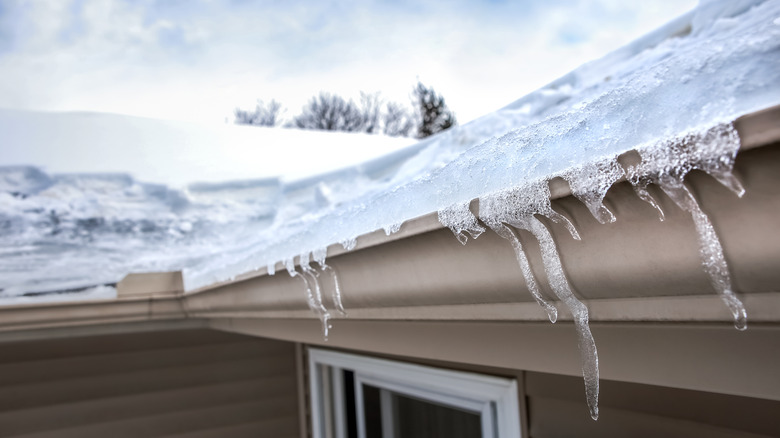How To Get Rid Of Ice Dams (And Prevent Them In The Future)
Ice dams, ridges of ice forming at roof edges, pose significant threats to homes by obstructing melted snow's drainage. Ice dams occur when the upper part of a roof reaches above freezing and snow begins to melt, with the resulting water refreezing at lower, colder roof sections. This dam may grow as it collects more melted snow, eventually forcing water into the home, affecting walls, ceilings, and more. The presence of ice dams can lead to severe issues, including structural damage from the weight of the ice, reduced insulation effectiveness, and potential mold growth. One quick way to address them is by using salt pucks.
Before starting, ensure you are equipped with necessary safety gear, such as gloves and eye protection, as calcium chloride can irritate the skin and eyes. Additionally, make sure you have a stable ladder to access your roof safely. Place the salt puck directly on top of the ice dam — positioning it near the dam's edge is crucial to establish a drainage path for the water. Allow some time for the salt puck to melt through the ice dam. The duration will depend on the thickness of the ice and the outside temperature. Keep an eye on the progress. You should see a channel forming in the ice dam, allowing the trapped water to drain off the roof. If the ice dam is extensive, you may need to use additional salt pucks to create more drainage channels.
How to prevent ice dams
Salt pucks melt ice by reducing water's freezing point. They dissolve into sodium and chloride ions, breaking the hydrogen bonds between water molecules and turning ice into water. Although an effective, quick fix, it's a good idea to use long-term preventative measures to prevent ice dams.
Begin by sealing off attic bypasses, which are insulation gaps that let warm air rise, heating the roof and causing snow to melt and refreeze into ice dams. Ensure that your attic is adequately insulated to minimize heat escape. Also, maintain proper attic ventilation to keep the roof temperature low and deter ice dam formation.
Implementing an ice-and-water barrier during your next roofing project can provide extra protection. This self-sealing underlayment is installed beneath the shingles, waterproofing the roof decking. Installing de-icing cables along the roof's edge can create channels for melted snow to escape as well. Regularly removing snow from the roof using a roof rake or a stiff-bristled push broom eliminates an essential component for ice dam formation. Hiring a professional for snow and ice dam removal is a safe and effective option for those not comfortable working on roofs. Proactively taking these steps can significantly reduce the risk of ice dams and safeguard your home from potential damage.
